Jane Austen’s Northanger Abbey to be reworked by Val McDermid
 I haven’t been this literarily excited in a long, long time. One of my favorite authors, Val McDermid, has been chosen to update Jane Austen’s least well known novel, Northanger Abbey, for a modern audience:
I haven’t been this literarily excited in a long, long time. One of my favorite authors, Val McDermid, has been chosen to update Jane Austen’s least well known novel, Northanger Abbey, for a modern audience:
Northanger Abbey is the story of the gothic novel-obsessed 17-year-old Catherine Morland, a girl who “read all such works as heroines must read to supply their memories with those quotations which are so serviceable and so soothing in the vicissitudes of their eventful lives”. Leaving her home for the sophisticated world of Bath, she falls in love with Henry Tilney, only for a host of romantic entanglements to occur, particularly when she visits his home of Northanger Abbey – where, far from her imaginings “the breeze had not seemed to waft the sighs of the murdered to her; it had wafted nothing worse than a thick mizzling rain”, and where she goes on to suppose Henry’s father to have murdered his mother.
Here’s how McDermid explains her approach to the task of bringing a “frisson of fear” to Austen’s novel:
“At its heart it’s a teen novel, and a satire – that’s something which fits really well with contemporary fiction,” said McDermid. “And you can really feel a shiver of fear moving through it. I will be keeping the suspense – I know how to keep the reader on the edge of their seat. I think Jane Austen builds suspense well in a couple of places, but she squanders it, and she gets to the endgame too quickly. So I will be working on those things.”
McDermid’s adaptation will be published in spring 2014 by HarperCollins.
10 Famous Literary Characters Based on Real People
In mental_floss Stacy Conradt reveals the real-life inspirations for 10 literary characters. Her list includes Huckleberry Finn, Miss Havisham, and Severus Snape.
When Do You Stop Reading a Book?
I used to feel compelled to finish every book I started, even if I wasn’t enjoying it. But my approach changed about the time I turned 40, when I decided that life was too short to waste reading books that weren’t speaking to me. I remember very clearly the first book I decided not to finish: Geek Love by Katherine Dunn. My library catalog gives the book’s copyright date as 1989, and I think I tried to read it soon after it came out. And I know a lot of people love this book. And yes, I know what symbolism is. So please don’t attack me if this is one of your favorite books. I just found the whole premise distasteful and refused to finish it.
I was therefore interested when Publishers Weekly blogger Josie Leavitt asked when readers give up on a book. Here’s her answer to that question:
I read too many books to feel compelled to finish all of them. I give most books a fair shake, at least a hundred pages, unless it’s truly awful. I define truly awful as something that is poorly written, when all I can see are the errors. I don’t even mind reprehensible characters, as long as the writing flows well. There are books that will take me literally months to finish because I don’t want to spend too much with it, but I’m still curious about how it ends. I will often start another book while I trudge through the other book.
Right now there are more than 30 responses to Leavitt’s question in the comments section of the blog, most of them thoughtfully good answers.
Oh, I guess I should add that I never review a book that I haven’t finished reading. If I start a book but don’t finish it, you won’t hear about it here (well, OK, except for my confession about Geek Love).
So, when do YOU give up on a book? Let us know in the comments section here.
Stuart Evers’ top 10 homes in literature
For this list Evers “decided to restrict it to traditional homes in novels – ie buildings in which fictional characters live. With regret, therefore, I’ve had to leave out William Faulkner’s Yoknapatawpha County, Richard Ford’s Haddam, Patrick Hamilton’s The Midnight Bell, Joan Didion’s house in The Year of Magical Thinking, every home that Alice Munro has ever described, not to mention the prisons, bars and hospitals that are as much homes as they are establishments.”
He describes houses from novels such as Great Expectations, Wuthering Heights, and Beloved.
